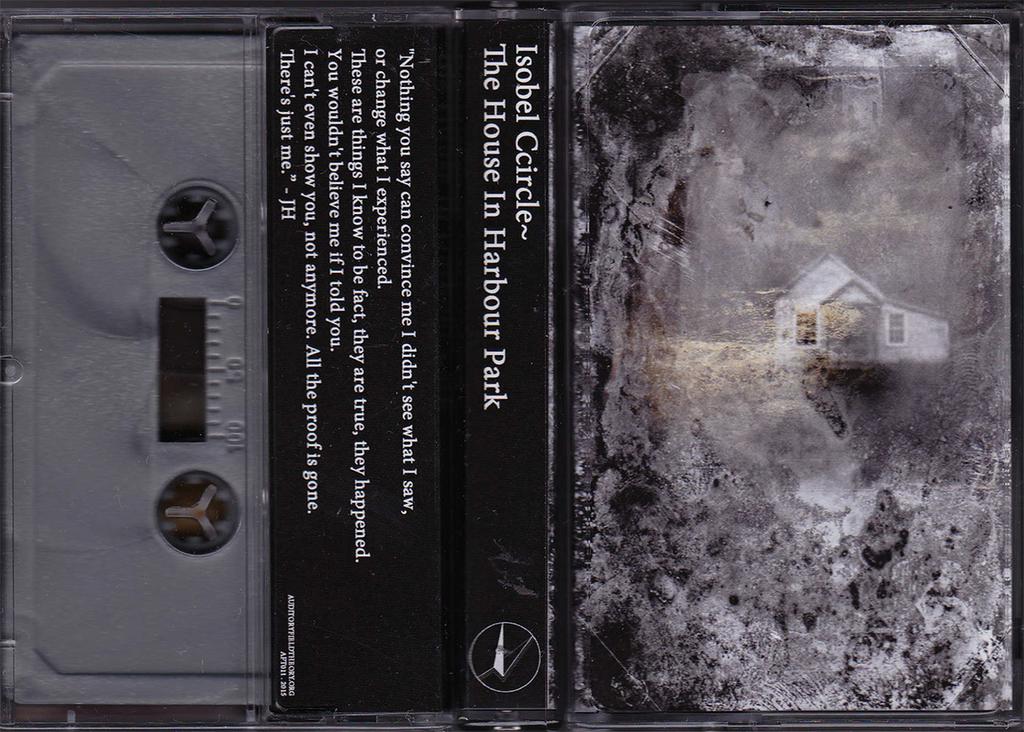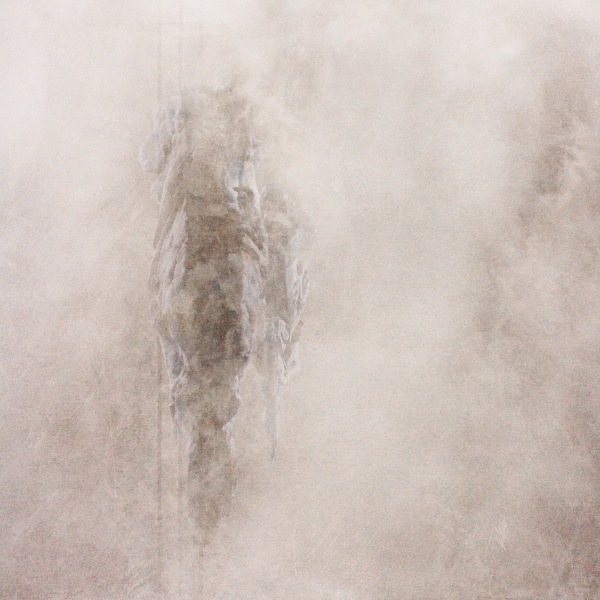
Detektiv J. H. istražuje tajanstvenu kuću i 3-D printerom materijalizira nevidljive prizore.
Inspired by the personal journals of Detective J.H. which chart his investigation into the mysterious events that took place in The House In Harbour Park, Isobel Ccircle~'s album is part Clem Snide investigation and part X File, painting a haunting and often terrifying picture full of strange occurrences and unworldly rituals.
Are you familiar with the method of loci mnemonic device for public speaking, where the speaker places the pertinent points of interest around a mental construct of their home?
This turns out to be a very useful method for relating to dark ambient/drone/noise based music, as well.
Isobel Ccircle~ is the much loved duo of April Larson and Matt Bower, of Wizards Tell Lies. The pair transmit from a liminal state, in the aether, from their respective homes of Louisiana and Lancashire.
The House In Harbour Park is described by the label as being “Inspired by the personal journals of Detective J.H. which chart his investigation into the mysterious events that took place in The House In Harbour Park, Isobel Ccircle~’s album is part Clem Snide investigation and part X File, painting a haunting and often terrifying picture full of strange occurrences and unworldly rituals.”
Even with some digging, not sure who this detective J.H. is, but The House In Harbour Park sounds like a time traveling adventure for William Hope Hodgson’s Carnacki, The Ghost Finder, if he were to investigate a crumbling, decrepit two-story ranch house.
The sounds contained on this ferric document are arranged as a continual, drifting soundscape, swathed in murk and fog, and are best taken whole, to simulate the experience of wandering through this dusty, dimly lit environment, stage for all manner of unwholesome activities. Each “song”, or “chapter”, could then be interpreted as an individual room, with titles and thumbnail imagery, to illustrate the ambiance, and provide a bearing to orient by.
Room 1: Vaporized Mercury – As you enter the home, whose walls seem to swell and breathe in a most sickly fashion, it seems that the typical laws of physics have been suspended, as drops of condensation plummet towards the ceiling. All right, then, you can check yr skepticism at the door. Something is going on here…
Room 2: Harbour House Room 3 (Flashlight In The Fog) – Yes, that’s right – Room 3 is the second room; conventional nomenclature has no hold here. The air thickens with particulate condensation, obscuring yr vision to two inches in front of your face. You can hear yr pulse in yr ears, and distant droplets of water, as you try to remember which way is forward. It seems as if you’ve always been in this mist. You’re beginning to lose track of how long you’ve been in the house. Better hurry up…
Room 3: The Keyhole Observations – You press yr eye to the black void of a keyhole, to observe a room warmly lit, like the hour of sunset, although it was barely noon when you entered. The room looks calm, inviting; you turn the antique bronze handle, to find the room cold gray, damp, and abandoned, the same as the rest of the house.
Room 4: Harbor House Room 2 (Noises In The Vents) – Vengeful spirits are always fond of ventilation. They love to throw their voices through the tinny, tiny openings, speaking in garbled, alien, bit-crushed tones, that cannot be replicated by vocal apparati. It seems that this house may have some hallucinogenic fungus in its vents; you feel like yr breathing a mixture of ergot and belladonna. Should’ve brought a mask; too late now. The walls seem to breathe, swell and shudder with renewed intensity.
Room 5: Exorcism Relocation Map – The fifth room, entirely vacant, except for a chalk circle drawn on the floor. In the center, a map, marking victims of demonic possession, and their current locations. What’s stranger, is these X’s seem to be moving on the paper! Are these the victims, or the traces of unclean spirits, moving about the physical plane?
Room 6: On The Fifth Night (Tears And Talons) – Up the stairs, and on to the second story – the floorboards seem to sag under yr weight in a very worrisome fashion. Although it is daytime outside the windows, you can hear the hoot of night owls, and what sounds like the clanging of ships’ masts, although yr nowhere near a body of water. Someone’s memories? Or yr own shaken nervous system? It’s so hard to hold on to what’s real, in this place.
Room 7: Harbour House Room 1 (Survive) – You can barely remember what you came in here for. There is only forward motion now, opening one door after another. It seems you have always wandered these hallways. Yr not even scared anymore, just drifting.
Room 8: Voices In The Dial Tone – An antique phone rings on a nightstand, despite its cord being frayed and cut from the wall. You pick it up, hesitantly, to hear what sounds like a ten ton Frog God on the other line, speaking yr name, trying to be coaxing. It’s not working, this voice knows nothing of seduction and enticement. This is the sound of swine devouring infants, of tears in the night; of crushing, inescapable despair.
Room 9: Voisix – How’s this going to end? Nearing the end of the corridor? Slightly intimidated by the notion of returning the way you came. You open the ninth door, and find endless, empty night sky. The stars have all burnt out, there is no illumination, nothing to orient by. The long dark night of the soul. It makes you want to lie down and sleep; you almost succumb. It takes all yr reserves to stay on yr feet. You hesitantly shut the door, with all of yr might.
Room 10: Stuck In Harbour House – You can no longer even remember yr own name, let alone what inspired you to come into this ramshackle structure. Those that live here no longer have to hide; the shadow grow eyes and fangs, and you can taste the thick spoor of mold and bacteria in yr throat. A distant beating – is that yr heart? Or the pulse of the house? Perhaps the beating of a sacrificial drum, or an approaching storm. Yr not worried – you have nothing to protect.
Room 11: Their Names Were Buried With Their Corpses Just To Be Sure – It’s all clear now. They’ve shown themselves. How awful, to be forgotten. How awful, to be nameless. Back into the legions of chaos, the nameless and the unnameable, with dread forgotten Gods and crawling, pinching creatures that live beneath blood and manure soaked soil. They want yr name. They want yr history. They want to walk in the light. Not for comfort, or for joy; just to wreck and wreak havoc. The window, with glass like a guillotine, beckons mockingly; only yr hatred of cliche saves you from returning to the natural laws of gravity, with a graceful swan dive to disaster. No. You will come back the way you came. You will tell others, or forget, what you saw hear, heard here. And then you will burn this fucking house to the ground.
Writing critically about Isobel Ccircle~ and The House In Harbour Park reveals something interesting, on the topics of Psychogeography and the analog vs. digital debate, illustrating a push/pull dichotomy between knowing and wonder.
Psychogeography began as a way to reclaim urban spaces from the onslaught of capitalism, where it seemed that you had to pay to be anywhere. If yr not shopping, you have no reason to be! It also was designed to free up citydwellers from rat maze lifestyles, comprised only of eating, working, and sleeping. Capitalism can be a prison, and we’re looking to pick the locks.
Psychogeographers are modern day urban shamen, looking for leylines beneath cobblestones, ghosts and spirits amongst shopping centers and anonymous suburban housing. It invites you to wander about, aimlessly, drifting, just looking, sensing, tasting.
This lamentation of late capitalism, at the demise of the curiosity, of the unknown. A nostalgia for nostalgia, as it were – remembering the ability to forget. We are all burnt out by the immediate knowing, so we take to the streets, desperately seeking something new, something miraculous, something curious. We’re willing to risk pains of hell to find it.
This results in hordes of antiquarians, scouring city streets with camera phones and GPS; a nation of Urban Explorers and Hauntologists, documenting the decay. The funny, almost ironic, dichotomy of this movement is that it fosters both an interest and a passion for the funky, obscure, run down and out of the way (which is a good thing). We LOVE holes in the walls. We LOVE dilapidated curiosities. There are leagues and leagues of tumblrs and pinterest boards to prove this.
At the same time, we are absorbing these relics into the simulacrum, making them known, quantifiable, becoming another commodity, like all the rest.
I was lucky enough to get a copy of The House In Harbour Park on analog cassette (sadly gone at the source now), and have spent numerous hours, drifting around this domicile, flipping the silver tape over and over, with nervous fingers.
The sound on the tape is unknown, unbroken. There are no words, and you will find no track titles on the liner notes. Just a series of evocative images. I didn’t even know how many songs there were, until i cued up the attached download.
So which is better? Do you prefer to leave the sounds alone, let them speak for themselves? Or do you need hard facts and data, to discern this release from the howling mob of amorphous drone releases out there?
I postulate a third way – a middle pillar. An easy peace, between the funky and the real, and the archive. We can use data to file, sort, organize, recommend, locate, and share, while the physical seems to possess a magick, a sparkling aura, that can’t be captured with pixels and big data.
Any art that lures you into the real, into engaging with and exploring yr own life, the world around you, is performing a vital service. We can’t applaud enough.
Again, sorry to point you in the direction you can’t actually hold in yr hands (unless you scour), but let it serve as a reminder to keep an eye on Auditory Field Theory, as they are producing sweet, magickal documents. You need them all; get ‘em while you can.
The House In Harbour Park is available as a digital download, from Auditory Field Theory.
@isobelccircle
April Larson bandcamp
@ivorylabyrinth
Wizards Tell Lies Facebook
@ForestOfDark
WizardsTellLies.co.uk
Auditory Field Theory Facebook
@AuditoryField
AuditoryFieldTheory.org
